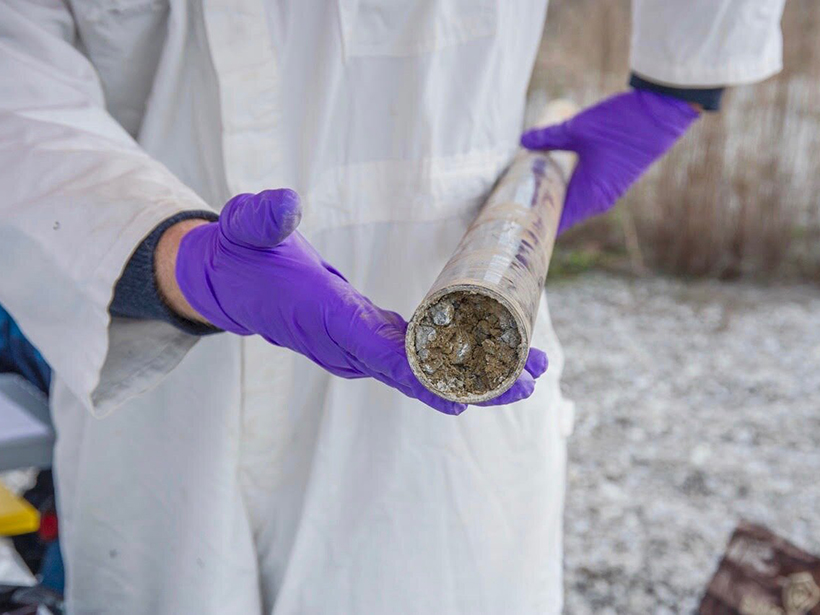Studying soil microbes can be a messy business. Soil compositions are varied, and detecting all microbes that live in the dirt can be difficult.

A team of scientists now has used a new technique for identifying active microbes in soil and even has color-coded different types of critters. The technique, presented in Nature Communications, can help researchers narrow in on soil microbiomes and uncover how they might affect soil processes.
Heterogeneity in Soil Microbiomes
Studying soil microbiomes can be challenging because soil is heterogeneous, says Rex Malmstrom, staff scientist at the Joint Genome Institute and coauthor of the study. He notes that soils can change drastically over very small distances (even millimeters) simply by differences in moisture, organics, or even sediment size.
Parsing out which microbes are living in a soil is “almost impossible” because soils are dense, complex, and opaque, says Darian Smercina, a doctoral student in the Department of Plant, Soil and Microbial Sciences at Michigan State University. She was not involved in the study.
Smercina says scientists have traditionally relied on indirect methods, like analyzing DNA, to determine what microbes are in the soil. “However, when we collect DNA from soil, we get not only DNA from active microbes, but DNA from microbes that have died [or] are dormant.”
Getting DNA from inactive microbes can muddy the water in microbiome studies. Malmstrom explains that determining which cells are active or inactive is important when trying to understand which microbes consume certain organic matter or cycle nutrients.
BONCAT
To get a clearer picture of soil microbes, the research team applied a method called bioorthogonal noncanonical amino acid tagging (BONCAT). Malmstrom says BONCAT incubates cells found in soil with an amino acid called homopropargylglycine (HPG). Soil cells take up the HPG and incorporate it into newly made protein, effectively “labeling” the cell as active.
BONCAT allows the team not only to distinguish between the active and inactive cells but also to sort different cells and recover and sequence them.
In addition, HPG has a unique side chain in its molecule that allows the scientists to “do this thing called a ‘click reaction,’ and that will add a fluorescent molecule to the HPG,” says Malmstrom. The process color-codes microbial types with different fluorescent colors, allowing the team not only to distinguish between the active and inactive cells but also to sort different cells and recover and sequence them.
The team used BONCAT on soil samples taken near Oak Ridge National Laboratory in Tennessee from two depths, 30 and 76 centimeters. The soil was incubated with HPG for up to 1 week, and fluorescence was added. The researchers added water to the samples to kick-start any inactive cells to get a full picture of the microbial communities.
Malmstrom says the results were surprising. “We added water and within hours, half of the cells [from the deeper sample] were already labeled.” He says that within 2 days, the active cells reached 60%–70%. In the 30-centimeter sample, the number of active cells maxed out around 25% after wetting.
Smercina agrees that it was surprising to see that the deeper sample was composed primarily of active cells. “It is thought that microbes in deeper soils are likely to be less active and/or slower growing,” she says, “but this does not appear to be the case.”
The sheer number of active microbes was an unexpected discovery, says Smercina. “Previous work has suggested that a much smaller portion of the community is active,” she notes. “This is very interesting, as it highlights how much we still have to learn about soil microbial communities.”
Leveraging Microbes
Malmstrom says BONCAT is a new tool for studying soil microbiomes and that researchers can use it to test what microbes are active in specific conditions. For example, he says it would be helpful to see the microbial changes after adding phosphorus or certain organics.
Smercina says that using BONCAT is likely to improve the understanding of soil microbial communities. “I can envision an agricultural application that allows assessment of the active soil community in a farmer’s field.”
She adds that “coupling this knowledge with advancing plant and soil research may allow us to tailor farm management practices to get the most benefits based on which microbes are active and what they can do.”
Although Smercina notes that some potential biases may crop up in the method via uptake of HPG and sorting, she says the new method is likely to be very useful in the research community. “I think we will learn a lot about the soil microbiome using this method.”
—Sarah Derouin (@Sarah_Derouin), Freelance Journalist
Citation:
Derouin, S. (2019), New tool reveals that soils are teeming with active microbes, Eos, 100, https://doi.org/10.1029/2019EO130261. Published on 06 August 2019.
Text © 2019. The authors. CC BY-NC-ND 3.0
Except where otherwise noted, images are subject to copyright. Any reuse without express permission from the copyright owner is prohibited.

